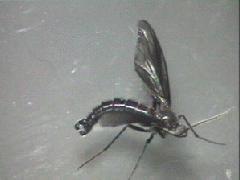Source(s): W.A. Attwater, University of Guelph, Ontario.
DARK-WINGED FUNGUS GNATS (Diptera: Sciaridae). Dark-winged fungus gnats or sciarid flies, primarily in the genus Bradysia, are pests of ornamental and other potted plants.
Adults are 3-4 mm long and gray-black. They are common on soil surfaces or under leaves in moist shady places, especially in areas such as greenhouses. Adults are weak fliers and often run over the surface of soil. They are often attracted to lights in the house at night. Adults live approximately one week and do not cause feeding injury to plants.
Female flies can produce between 75-200 smooth, oval, white eggs which are laid on the soil surface and in crevices. Larvae emerge in 4 to 6 days and are creamy-white with black heads. Complete development occurs within 2-3 weeks at 22 °C, which is a common house temperature. The pupal stage appears as a thin cocoon, and lasts 4-6 days at 22 °C. Several generations of flies commonly overlap.
Larvae of several species feed on decaying organic matter and fungi in soil. Media mixes with a high peat content can favour infestations, especially in the presence of decaying plant tissue. The larvae also feed on rotting plant roots and lower stem tissue. They seldom affect sound plant tissue. Some species occasionally become pests in mushroom production operations.
Controls
- Remove breeding sites such as infested soil and decaying plant material.
- Replace infested mixtures with sterilized soil.
- Seal bags of opened sterilized soil.
- Allow the soil to dry between watering of houseplants.
- Follow good sanitation practises.
- Use screening on windows, doors and vents.
- Beneficial (entomopathogenic) nematodes and predatory mites are available for the control of fungus gnats.
- Insecticides with a domestic registration are also available.
- Use the recommended rates and follow all safety precautions given on the manufacturer’s label.
Center Publication Number: 168
- Dark-Winged Fungus Gnats - September 23, 2013
